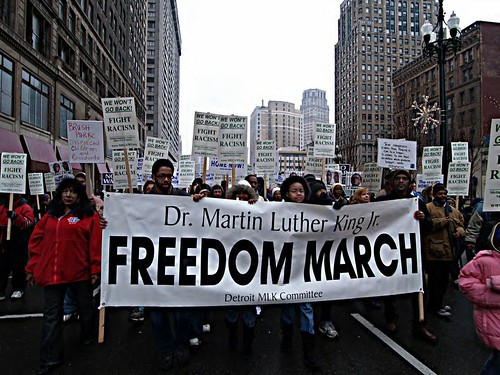
Detroit Martin Luther King Day demonstration through Downtown Detroit on January 15, 2007. The march draws upon the legacy of Dr. King's peace and social justice work. (Photo: Robert Akrawi)., a photo by Pan-African News Wire File Photos on Flickr.
Gloomy Outlook for Black America, Scholars Conclude
by Herb Boyd
Special to the NNPA from the New York Amsterdam News
A group of leading Black intellectuals met at the Schomburg Center for Research in Black Culture to discuss the current plight of African Americans in the United States.
Curiously, at the recent forum, which took place Feb. 26 and was entitled “Black America: A Prescription for the Future,” alongside their programs, attendees were given an article published in the Journal of Negro Education in 1936.
That conference apparently ended without the delegates accepting any of the proposed solutions.
Those participants might have benefited from the work of the panelists at the Schomburg, particularly the remedies offered by Dr. Bernard Anderson, Dr. William Julius Wilson, the Rev. Al Sharpton and Dr. Richard Kahlenberg.
In 1936, with the solutions seeming unacceptable, the delegates agreed that a next step was necessary and they called for a national Negro congress under the auspices of the great labor leader A. Philip Randolph.
More than 75 years later, Norman Hill provided a living connection to Randolph at the Schomburg as president emeritus of the A. Philip Randolph Institute (APRI).
Hill’s task was to set the stage for the panelists with an overview of the Civil Rights Movement, and he did that quite elaborately, covering from 1896 to 1965.
Hill delivered his presentation after a general welcome from the moderator, professor Jerald Podair, and greetings from Vincent Alvarez, president of the New York City Central Labor Council, AFL-CIO; Clayola Brown, president of the APRI; and a representative from the NFL Players Association standing in for executive director DeMaurice Smith.
To address the problems facing Black America, Hill said the renewed movement would be wise to follow the principles and credo of his mentor, Randolph.
“At the banquet table of nature,” Hill began, quoting Randolph, “there are no reserved seats. You get what you can take and you keep what you can hold. If you can’t take anything, you won’t get anything, and if you can’t hold anything, you won’t keep anything.
And you can’t take anything without organization.” A barrage of statistics came from Anderson and Wilson, with only the cogent words of Sharpton providing a pause. An esteemed economist, Anderson’s analysis is often found in the National Urban League’s annual State of the Nation report.
He shared some of that information with a fairly sparse but attentive audience.
On the question of jobs, Anderson said, “Blacks comprise 20 percent of the unemployed.”
And that number may be even higher if you include those no longer looking for work and the underemployed. “When you stop looking for work, you are no longer listed among the unemployed,” he said.
His was a litany of despair as he compared the prospects of Blacks to a train’s caboose. “No matter how fast the train is going, the caboose [Blacks] will never catch up to the engine [whites].”
Sharpton’s main thesis had less to do with comparing Blacks to whites and more to do with the expanded Black middle and upper class and the poor or lower class they’ve left behind. “What we did during the Civil Rights
Movement was to empower and create a Black upper class while ignoring the Black lower class. Our Black billionaires sold their businesses and cashed out.
“We have to get back to a bottom-up movement,” he continued. “It’s time to get back on track.”
Getting back on track, he insisted, would entail paying attention to the GOP and its aim to suppress the Black and minority vote and, with the help of the Supreme Court, put an end to affirmative action.
“I agree with Dr. Anderson: We must, in the tradition of Frederick Douglass, agitate, agitate, agitate!”
Many of the dismal conclusions recited by Wilson merely confirmed what Anderson had already presented.
And like Anderson, he said it “will take generation for the Black family to catch up with the white family” in terms of wealth and income.
“Seventy percent of Black children who now live in poor communities will continue to live there as adults,” Wilson added.
The shift in demographics, he explained, has created largely African-American core centers in our major cities. “The Black middle class has abandoned the inner city and now populates the suburbs,” he said.
So what’s to be done? “President Obama, rather than specifying a bill that would target Black Americans, needs to create a bill designed to create public sector jobs,” Wilson said.
Of course, most of the people who would benefit from such a bill would be Blacks.
Kahlenberg’s report was equally depressing as he focused on the gross disparities between Black and white school children.
He observed that since Black primary and secondary students attend schools in poor areas, they are less likely to receive a quality education and not get the same books, new technology or audio-visual equipment as a white school district.
Unlike one of the conclusions reported by Wilson, Kahlenberg said that Black students perform “better when given a chance to attend better schools.”
His solution to some of the problems hindering Black empowerment centers around what he calls “a new type of afirmative action,” one based not on race but on class.
“Blacks would still be the greatest beneficiary of an economic approach, since they are the worst off,” Kahlenberg concluded.
No comments:
Post a Comment